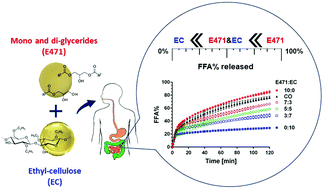Controlling lipid intestinal digestibility using various oil structuring mechanisms
Abstract
This research demonstrates the ability to direct the rate and extent of lipid hydrolysis of oleogels using a combination of different structuring agents. Combinations of ethyl cellulose (EC) (20 cP and 45 cP) and commercial mixture of mono and di-glycerides (E471), at different ratios, were examined. The results suggest that the combination of E471 and EC significantly affects both gel physical properties and intestinal lipolysis. The gelation profile of the combined system demonstrated the EC sol–gel transition, which is characterized by G′ = G′′ at high temperatures (∼100 °C) followed by a soft-to-hard gel transition at low temperatures ∼30 °C, which corresponds to E471 crystallization. Such a profile suggests the formation of two gel networks, with the polymer network acting as a platform for E471 crystallization. Mechanical analysis reveals harder gels in the E471 : EC 20 cP mixture compared with the simple addition of each component contribution, suggesting a synergistic effect with a typical maximum at 7 : 3 E471 : EC 20 cP ratio. No significant additive effect was observed for E471 : EC 45 cP mixtures. Maximum lipolysis in the order of EC < E471 : EC < E471 was obtained, implying an effect of the structuring agent used on the lipolysis profile. A first-order kinetics analysis fitted to the lipolysis profiles demonstrated rate constant values in the order of E471 < E471 : EC < EC. Such behavior was attributed to the oil state, liquid vs. solid, and the network strength, both of which limit the lipase activity by hindering liquid TAG accessibility. Overall, the results demonstrate the ability to control gel properties and hydrolysis by manipulating gel composition. Such rational design can be exploited when developing new fat mimetic systems aimed at controlling the lipid digestion profile or the release of hydrophobic components present in the oil phase.

- This article is part of the themed collection: 8th International Symposium on Delivery of Functionality in Complex Food Systems (DOF 2019)


 Please wait while we load your content...
Please wait while we load your content...